I have been using a Garmin Epix Pro running/outdoors watch for a number of years. This post isn’t a “which is better” Garmin v Apple Watch comparison—both watches excel at what they do but in different ways.
The goal of this post is to challenge my own preconceptions about the Apple Watch and determine whether it better meets my smartwatch, running, and outdoor needs over my Epix Pro. I will update this post every few days. As of Day 1, my gut feeling is that I will be back to my Epix Pro before the 30 days are up—my biggest concern is battery life. Time will tell…
Day 1
I decided to wipe all my previous Apple Health data and start from scratch. My Garmin scales will handle the essential metrics, while the Apple Watch Series 10 will track everything else over the next 30 days.
I was already anxious about battery life, to the point where I turned off some app notifications. I set up the watch the night before and was immediately impressed by the screen quality. Here we go.
Day 2
Technically, this is Day 3 as I lost yesterday to a migraine. At 6:00 AM, I decided not to check battery life obsessively—I knew that if I started, it would become an obsession. Instead, I focused on my first Apple Fitness workout: a 30-minute treadmill run. The on-screen metrics were useful, but at 6 AM, the instructor’s enthusiasm was a bit much for me.
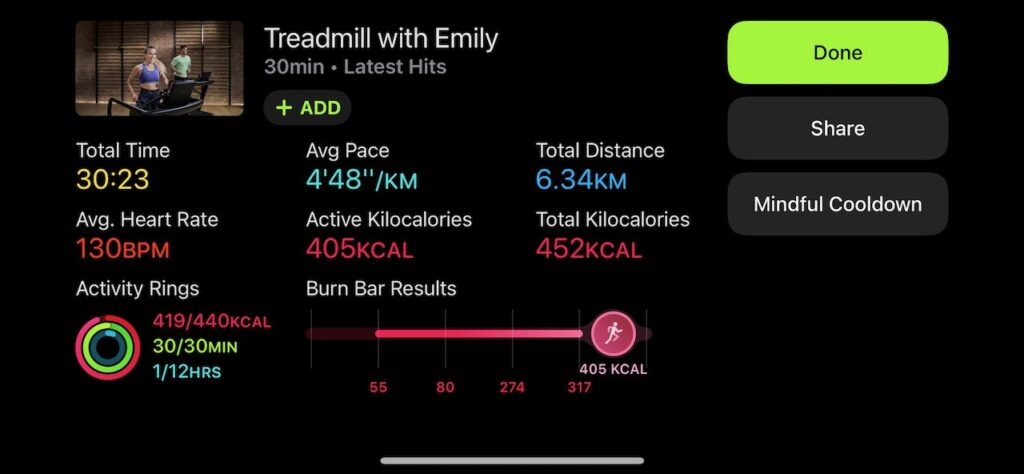
The instructor asked questions, and even though I didn’t respond, she reacted as if I had. When I muttered, “I didn’t say anything,” she ignored me. This kind of interactive energy will take some getting used to if I continue with Apple Fitness+. Note that this isn’t a criticism—Northern Irish people tend to be reserved, and I was still grumpy from the migraine.
Click here for a relevant update.
Update on Day 21: After a few more workouts, I now understand the structure of Fitness+ workouts. I highly recommend Emily’s treadmill sessions—her half-marathon time is closer to my 10K time!
At 7:10 AM, I put the watch on charge. By 8:00 AM, I got an alert that it was fully charged. That was faster than expected, but I had also minimised interactions, and my run didn’t require GPS.
Day 3
Another day lost—this time due to a reaction to my second COVID vaccination.
Day 4
The Day of the Apps Recovering from the vaccine, I realised I was missing some of the metrics my Garmin provided. I reinstalled Zones and HealthFit, apps I had explored years ago. Both had received significant updates, and I was impressed with how they presented data from my single activity.
A new app for me was Heart Analyzer. It was an eye-opener—not just in terms of functionality, but also in showing how much data the Apple Watch collects. The watch’s simplicity does not mean it lacks advanced features. I even ran an ECG to provide more data for Heart Analyzer. I’m excited to see how this information builds over time.
At 11 PM, I found an app to replace my love for Garmin’s Body Battery metric. I had tried a Whoop band before but found it overwhelming. The Training Today app, which uses HRV to guide daily training readiness, is a simpler alternative. The app recommends 60 days of data for better accuracy, but even now, the graphs clearly illustrate my struggle with the vaccine side effects.
Day 5
This was going to be a critical test—24 hours without charging and two long activities. I charged the watch to 95% before heading to the mountains.
During the day, I completed a 90-minute forest walk and a two-hour mountain hike. I even took two calls on the watch (which felt ridiculous, but my phone was in my bag).
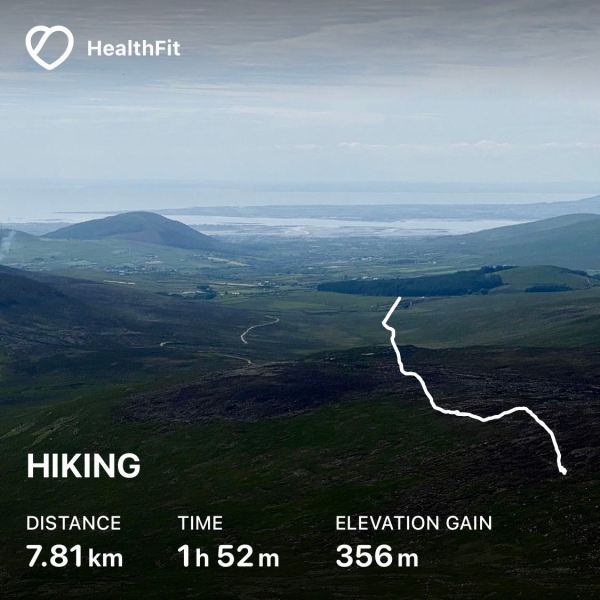
I didn’t check the battery all day. When I got home at 6 PM, I expected it to be at 10-20%. To my surprise, it was at 48%! I continued tracking sleep and charged it the next morning.
Day 6
I woke up, grabbed coffee, and put the watch on charge. An hour later, it was fully powered. Compared to my Epix Pro, that’s still weak, but it exceeded my expectations.
Reviewing my activities in various apps, I noticed that Apple Watch estimated my VO2 max at 42 after my hike. My Garmin had me at 47, but since I haven’t done any outdoor runs with the Apple Watch yet, it’s too early to compare accuracy.
I’ve also fallen in love with the HealthFit app. Initially, I got it for Strava integration, but it has become a data haven. I can analyze my activities by explorer score (which tracks new map tiles covered), heatmaps, and even activity analysis by photos. HealthFit also allows exporting activities as shareable images.
Day 7
Today I discovered the brilliant WorkOutDoors app for planned training runs. It’s impressively powerful yet incredibly easy to use. The app functions similarly to Garmin’s workout feature, allowing you to set targets like pace, distance, and time. I’m excited to see how this works in practice.
I also did my second Apple Fitness+ workout, albeit a short one. I’m still loving how the metrics are displayed, and I was surprised at how challenging the 10-minute workout was. This service is definitely impressive, and I’m eager to explore the different programs available. Right now, I only see three options, and the pregnancy program, of course, isn’t relevant for me.
An afternoon walk caused a significant fluctuation in my VO2 max. My Garmin estimated my VO2 max at 47, but yesterday’s hike put it at 42, and today’s walk dropped it to 37. I’m unsure how to interpret this—perhaps it’s too early to tell, I haven’t run outside with the Apple Watch yet, and it seems strange that a casual family walk could cause such a large drop. I’ll keep an eye on this metric.
Day 8
I woke up at 6 AM, and despite a quiet day yesterday with just a one-hour walk, I was happy to see my Apple Watch had 56% battery left. After my 5km run, I charged the watch while I showered, and it was back up to 80% in no time. Meanwhile, my Garmin is still sitting on the charger with plenty of life left. I think I’ll get into a routine of charging the watch during my downtime.
My VO2 max increased to 41, though it’s still off Garmin’s estimate of 47 (based on a year’s worth of data). It could be that Apple Health needs more time to establish an accurate baseline, or maybe Garmin’s prediction that I’m in the top 20% for my age is a bit of an overestimate. Only time will tell.
I added two new apps today: Heart Watch 4 and FITIV. Heart Watch offers a nice interface that digs into your health data and provides different insights. I can see myself using various heart data apps over the next few weeks before deciding which ones meet my needs.
FITIV is more community-oriented and allows you to analyze your data while also offering a workout builder. Points are awarded based on performance, but some features require a subscription. I think I need to stop jumping between apps and focus on the basics.
The Apple Fitness+ app encouraged me to mark World Yoga Day with a 20-minute session. I initially kept putting it off but finally gave it a try, and it was a massive achievement. Not only did I complete it, but I also created an entertainment source for my kids. I’m slowly getting used to the Apple Fitness platform, though a structured program would definitely help. My core focus apps remain HealthFit, Heart Analyzer, and Zones.
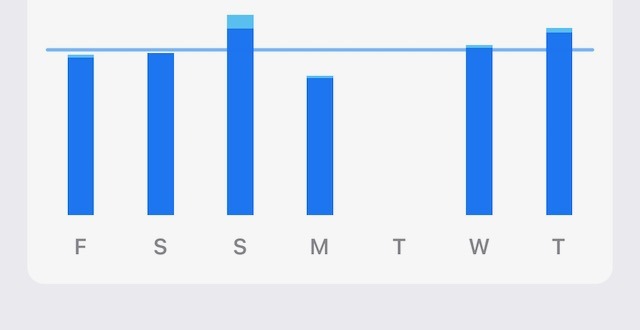
Day 9
Unfortunately, Day 8 ended with a small disaster. I had planned to charge my Apple Watch during the day but forgot. In the evening, I received a warning that I needed to charge it if I wanted to track sleep. I saw the alert, forgot about it again, and remembered at 11 PM. I plugged the watch in, fell asleep, and woke up just after midnight to put it back on. As a result, Health didn’t register any sleep data at all.
I topped off the charge in the morning and got it to 94%. It’s amazing how quickly it charges—I just need to develop a routine around it. Day 9 was relatively quiet. I completed a 5km run early in the morning and, after a full day, I attempted the internal yoga day challenge. The 20-minute session really wiped me out. After 20 minutes of charging at 11 PM, the watch was set to monitor sleep.
Day 10
The novelty of the new watch is starting to wear off, and now it’s time for a proper comparison. After a quick 20-minute charge this morning, I still had over 20% battery left. Once I get into a charging routine, I won’t be so obsessed with checking the battery level. As for the metrics, despite feeling tired, the Training Today app gave me a score of 8.1 with a “you can push harder” suggestion. The app recommends 60 days of data for accuracy, and I’ve only got 6, so this score may not be fully reliable yet.
I completed two short workouts and my second treadmill session using Fitness+. I enjoyed the 30-minute session, but there was a minor issue: during one of the hard pushes, my Wi-Fi cut out, causing the workout to auto-pause while I didn’t. What should’ve been a tough 30 seconds turned into a 60-second interval. It wasn’t a big deal, but I was worried the workout would be lost at 28 minutes in. I’m getting used to charging as I go, aiming for 90% by bedtime.
Garmin Epix Pro vs. Apple Watch Payments
By Day 10, I found myself using the Apple Watch more than the Garmin, particularly for card payments. While I did set up Garmin Pay, I always found it difficult to navigate. Apple Pay, on the other hand, is effortless—perhaps a little too easy, given my tendency to overspend.
Day 11: HRV Tracking
I’m now fully engaged with the watch and its health apps, though I’m still figuring out the metrics in Training Today. I’ve been using the Apple Watch more seriously since recovering from a migraine, which is reflected in the upward trend at the start of my HRV graph. The drop in HRV and rise in resting heart rate (dashed line) coincided with my second Covid vaccination, which took several days to recover from. I’m not sure if the migraine had any effect, but the graph certainly tells the story of my recovery.
Though I haven’t had much chance to run, I’ve been doing short Apple Fitness+ workouts, which I’m actually enjoying more than expected. It will be interesting to see how they affect my running performance.
Link: Training Today App
Days 12-13
These were easier days with just a couple of walks. During one short walk, the Apple Watch readjusted my VO2 max to 37.5, which is below average. Garmin had my VO2 max at 46-47 for the past 6-7 months (top 20% for my age), but Apple has me in the “below average” category. I’m hoping that once I get back into a regular running routine, this number will stabilize. On Day 13, I added CardioBot and HealthView—both are subscription-based but affordable. I’ll use both over the next few weeks and report on their progress.
Link: CardioBot
Day 16: HRV, Stress, and Other Metrics
The annual transition from June to July meant a few days off from fitness tracking. Looking at the data over the past week, some interesting trends have emerged. Training Today has accurately reflected how I’ve felt, with a drop in my score to 2.3 today after I finally managed a run. CardioBot also produced a report, cautioning me about the intensity of my workout. It was interesting to see how the app adjusted its HRV metric based on my recent activity.
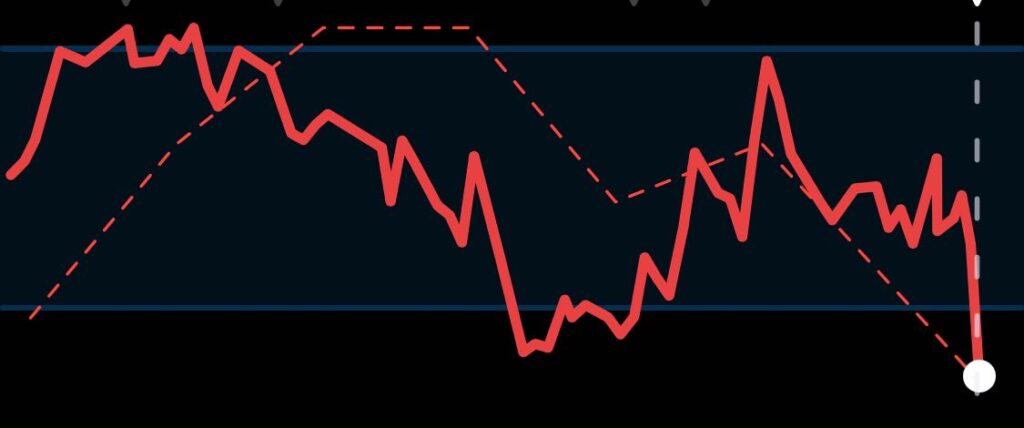
I’m now using a variety of apps that display the same data in different ways. CardioBot is highlighting that pushing hard might not always be beneficial, which is something I need to research further. The Heart Analyzer app has listed my max HR as 186, which I’ve updated in Strava. Additionally, I’m noticing a significant difference in my daily step count between Garmin and the Apple Watch—the latter is far less generous.
Days 17-19
The last few days involved hiking, running, and more Apple Fitness+ workouts. I’m now firmly in the routine of charging the watch, and the battery concerns have dissipated. I can easily complete several activities in a day without worrying about running out of power. The screen remains highly readable, even under bright sunlight during my hike.
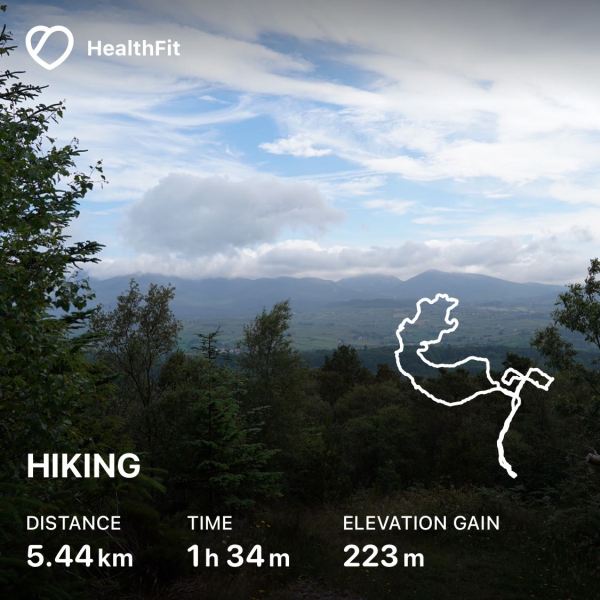
In terms of health metrics, Garmin Connect offers an exhaustive range of data, but I’ve come to realize I didn’t fully understand what the numbers meant. Now, using two or three apps, I’m starting to connect how I feel with the data. For example, when I’m fatigued, Training Today echoes this feeling with a numeric value. I may eventually take this knowledge back to Garmin Connect to make better use of their data, but for now, I’m getting valuable insights from these apps.
Day 20-21
I decided to explore a variety of activities using Fitness+ and other activity apps I had downloaded. While I typically use the default Apple Activity app, on Day 20, I wanted to target HR Zones 1-2 during a run.
The Zones app worked brilliantly for this purpose, and I followed it up with a ‘Time to Walk’ activity on Fitness+. Both activities went smoothly, and I was impressed with the interface on both the watch and in the Health app. An added benefit is that Apple Health serves as a data conduit, allowing you to export activity data to other apps. Below are images showing a walk tracked via the default Apple ‘Walking’ app, with data exported to HealthFit and Zones.
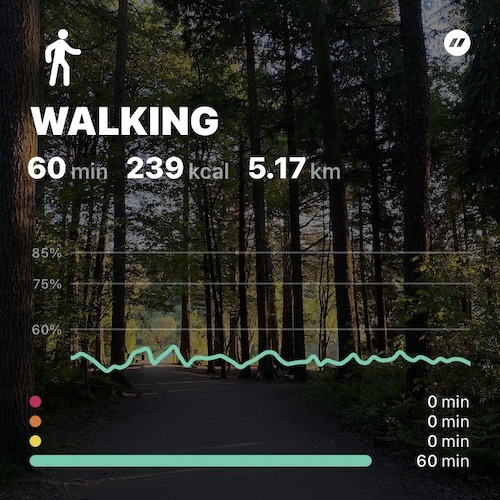
On Day 21, I went for an hour-long walk and checked how it impacted my Vitality Life Insurance Tracker. I noticed some activities were missing, so I reached out to Vitality for clarification. They updated my points for the 30-minute run but informed me that only activities tracked with the default Apple Activity app would count towards rewards. Third-party apps like Zones don’t count. This is a bit of a setback since structured workouts (common with Garmin) won’t contribute to Vitality rewards when tracked through third-party apps on the Apple Watch. However, the silver lining is that steps from running could still count for rewards, though this is a slower method. It’s a downside, not necessarily related to the Apple Watch itself, but definitely an advantage of the Garmin ecosystem.
Day 22: Tempo Run App
Following my conversation with Vitality, I received two useful messages. The first, from Mike, shared an easy workaround that lets me use the WorkOutDoors app alongside the native Apple running app. By using Intervals Pro, I can build a structured workout for the watch but disable tracking. I then launch the native Apple workout, and I’ll get voice prompts from Intervals Pro while the activity records natively on the Apple Watch. This is a great solution and ensures my structured runs count for Vitality.
The second message came from the developer of Tempo, a powerful training log for running and walking. Tempo aims to be your go-to daily training app, visualizing activity data and overall fitness performance. While there’s a risk of app overload, Tempo’s unique data presentation and stunning graphs caught my attention. It’s a subscription-based app, but at £9.48 per year, with a two-week trial, it was an easy decision. If you use an Apple Watch for running, this app should be on your iPhone.
Tempo also lets you fine-tune your activity tracking for walking and hiking. You can decide which types of walks and hikes to include in your data and even exclude certain metrics, such as pace. The app offers deep insights into your activity data and presents them in visually engaging graphs. For example, it tracks personal records and even celebrates your personal best with a fun animation.
Day 23-25
I’ve been cycling between the 3-4 fitness apps I’ve downloaded over the past few weeks, and it’s interesting to see how they display the same data in different ways. While Garmin provided a wealth of data, it often presented everything in a single view, making it harder to interpret.
With the Apple Watch, Apple Health acts as a database of raw data that different apps can access, analyze, and present. I particularly appreciate the way Apple Health integrates with Strava. After each run or hike, Strava alerts me to a new activity and allows me to decide which one to import. This offers a greater sense of control over my data. Moreover, I feel I’m gaining a better understanding of the metrics and their impacts.
Day 25-30
The past few days have been spent reviewing my apps and comparing the pros and cons of the Apple Watch versus the Garmin Fenix Epix Pro. Initially, I was concerned about keeping the Apple Watch charged, especially since my Garmin lasted ten days on a single charge. However, those concerns dissipated quickly after discovering how fast the Apple Watch charges each morning.
I’ve really enjoyed Fitness+ and can see it becoming a key part of my winter treadmill runs. My VO2 max, which was 47 (top 1%) on the Garmin, remains around 39 on the Apple Watch. While the number itself isn’t critical, tracking the deviations from 39 will offer more insight into changes over time.
I also learned I can automate ‘Do Not Disturb’ mode during activities. Notifications during runs used to be annoying, especially when they arrived early in the workout, leaving me wondering what the message was. This new setting solves that issue.
There have been a few instances where the Apple Watch seemed to misinterpret my running cadence as heart rate, but pausing the run for a few seconds resolved the issue. It’s something I’ll keep an eye on moving forward.
The Apple Watch also offers more flexibility in how data is presented through different apps, especially Strava. I can manually choose which activities to upload to Strava, unlike the automatic syncing with Garmin.
Apple Watch Conclusion after 30 Days
After 30 days, I expected to revert back to my Garmin, given its image as the go-to device for runners and outdoor athletes. But despite the appeal of the Garmin Epix Pro—especially in terms of its rugged outdoor credibility—I’ve come to appreciate the simplicity and power of the Apple Watch. Apple’s design ethos shines through: deceptively simple on the surface, but incredibly powerful beneath. Even without a significant presence among professional athletes, the Apple Watch offers most of the same metrics as a dedicated running watch.
Interestingly, I find myself more motivated by some of the Apple challenges and nudges. For now, at least, I’m sticking with the Apple Watch Series 10. That said, I may need to avoid any more information about the Garmin Fenix 8.
Links:


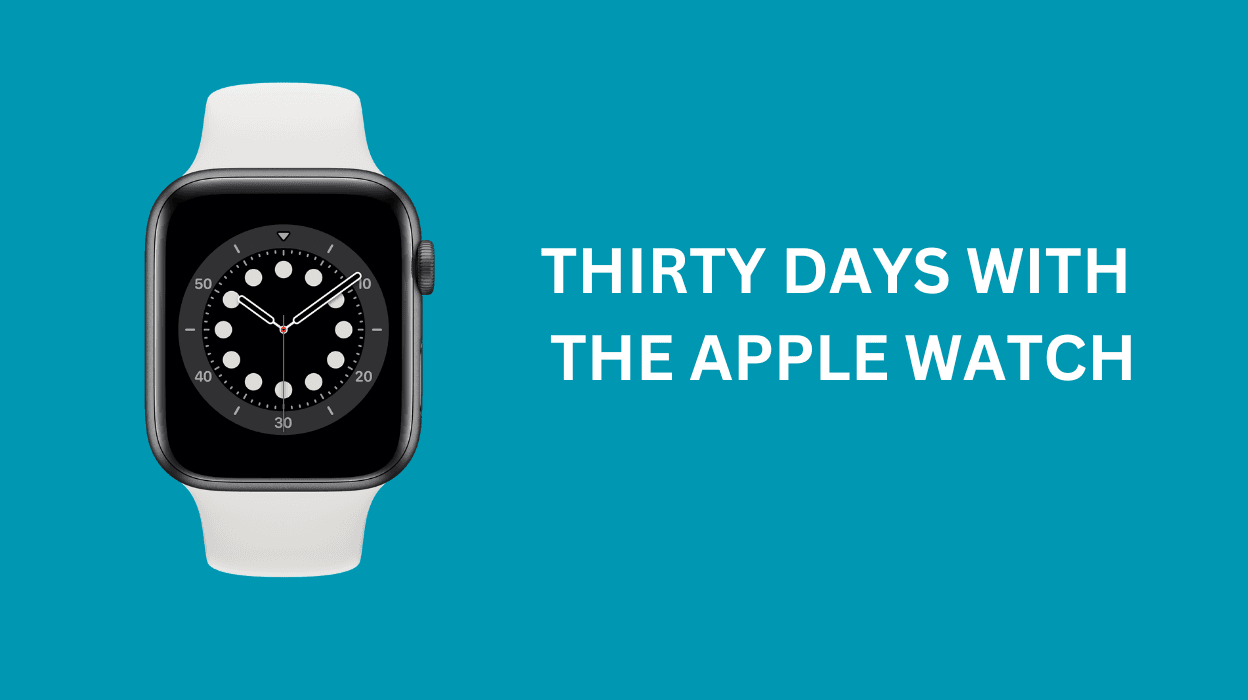


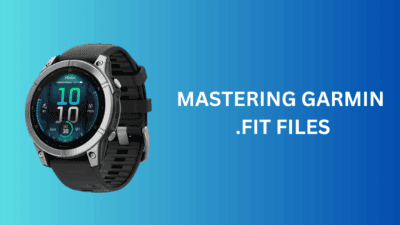

[…] this guide, we’ll walk you through how to set up and track an Apple AirTag using an iPhone or Apple Watch, explore smart ways to use them in daily life, and discuss key features like Precision Finding and […]